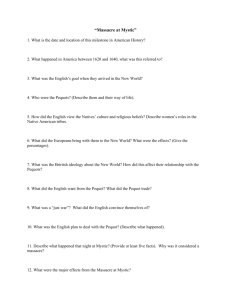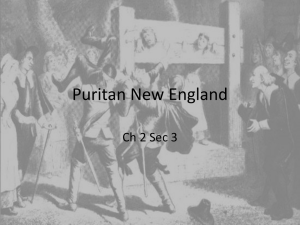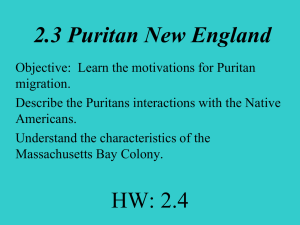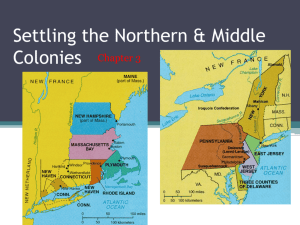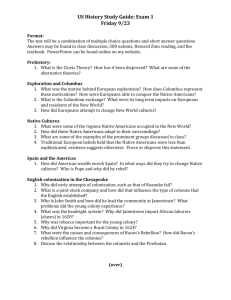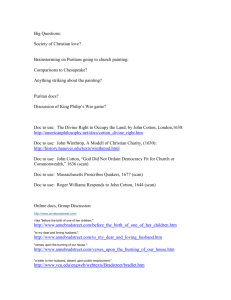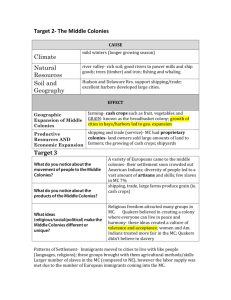Chapter 3
advertisement
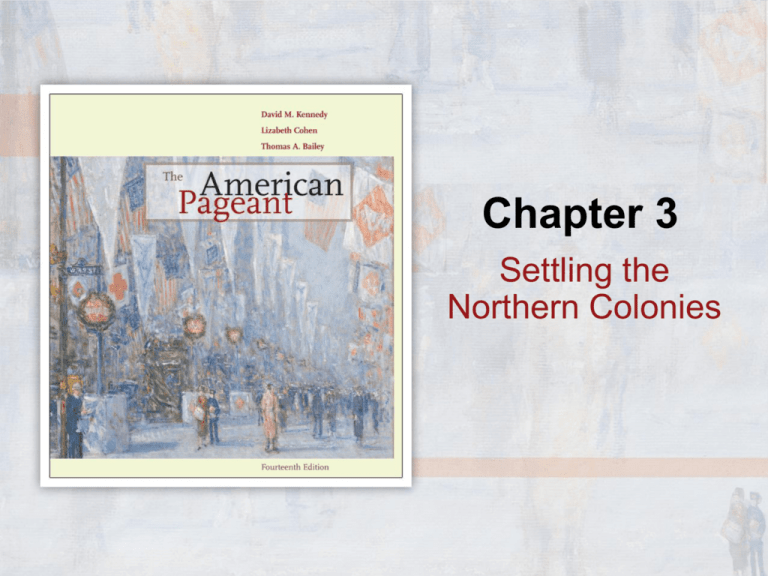
Chapter 3 Settling the Northern Colonies Plymouth Plantation Carefully restored, the modest village at Plymouth looks today much as it did nearly four hundred years ago. Sources of the Puritan “Great Migration” to New Eng land, 1620–1650 The shaded areas indicate the main sources of the migration. The Great English Migration, ca. 1630–1642 Much of the early history of the United States was written by New Englanders, who were not disposed to emphasize the larger exodus of English migrants to the Caribbean islands. When the mainland colonists declared in dependence in 1776, they hoped that these island outposts would join them, but the existence of the British navy had a dissuading effect. Anne Hutchinson, Dissenter Mistress Hutchinson (1591–1643) held unorthodox views that challenged the authority of the clergy and the very integrity of the Puritan experiment in the Massachusetts Bay Colony. An outcast in her day, she has been judged a heroine in the eye of history. This statue in her honor, erected in the nineteenth century, now graces the front of the Boston, Massachusetts, Statehouse. Seventeenth-Century New England Settlements The Massachusetts Bay Colony was the hub of New England. All earlier colonies grew into it; all later colonies grew out of it. Attack on a Pequot Fort During the Pequot War of 1637, engraving by J. W. Barber, 1830 This was the first war between natives and Europeans in British North America. It culminated in the Puritan militia’s vicious burning out and slaughtering of nearly three hundred Pequot men, women, and children. The defeat of the Pequots eliminated armed re sistance to the new settlements of New Haven and Guildford. The Connecticut Valley would not see significant “Indian troubles” again for forty years, when the Indians of New Eng land united in their final stand against the encroachments of English settlers, King Philip’s War. King Philip, also known as Metacom, is shown on the right. Attack on a Pequot Fort During the Pequot War of 1637, engraving by J. W. Barber, 1830 This was the first war between natives and Europeans in British North America. It culminated in the Puritan militia’s vicious burning out and slaughtering of nearly three hundred Pequot men, women, and children. The defeat of the Pequots eliminated armed re sistance to the new settlements of New Haven and Guildford. The Connecticut Valley would not see significant “Indian troubles” again for forty years, when the Indians of New Eng land united in their final stand against the encroachments of English settlers, King Philip’s War. King Philip, also known as Metacom, is shown on the right. Sir Edmund Andro’s (1637– 1714); a Boston Broadside Urging Him to Surrender, 1689 After being expelled from New England, Andro’s eventually returned to the New World as governor of Virginia (1692– 1697). Sir Edmund Andro’s (1637– 1714); a Boston Broadside Urging Him to Surrender, 1689 After being expelled from New England, Andro’s eventually returned to the New World as governor of Virginia (1692– 1697). Andros’s Dominion of New England Early Settlements in the Middle Colonies, with Founding Dates New York Aristocrats This prosperous family exemplified the comfortable lives and aristocratic pretensions of the “Hudson River lords” in colonial New York. New Amsterdam, 1664 The future metropolis, already a bustling port, is shown here as it was in the year that the English took over New Netherland and renamed it New York. Quakers in the Colonial Era Quakers, or Friends, were renowned for their simplicity of architecture, dress, manner, and speech. They also distinguished themselves from most other Protestant denominations by allowing women to speak in Quaker meetings and to share in making decisions for the church and the family. Quakers in the Colonial Era Quakers, or Friends, were renowned for their simplicity of architecture, dress, manner, and speech. They also distinguished themselves from most other Protestant denominations by allowing women to speak in Quaker meetings and to share in making decisions for the church and the family. Penn’s Treaty, by Edward Hicks The peace-loving Quaker founder of Pennsylvania made a serious effort to live in harmony with the Indians, as this treaty-signing scene illustrates. But the westward thrust of white settlement eventually caused friction between the two groups, as in other colonies. A Seventeenth-Century Valuables Cabinet
